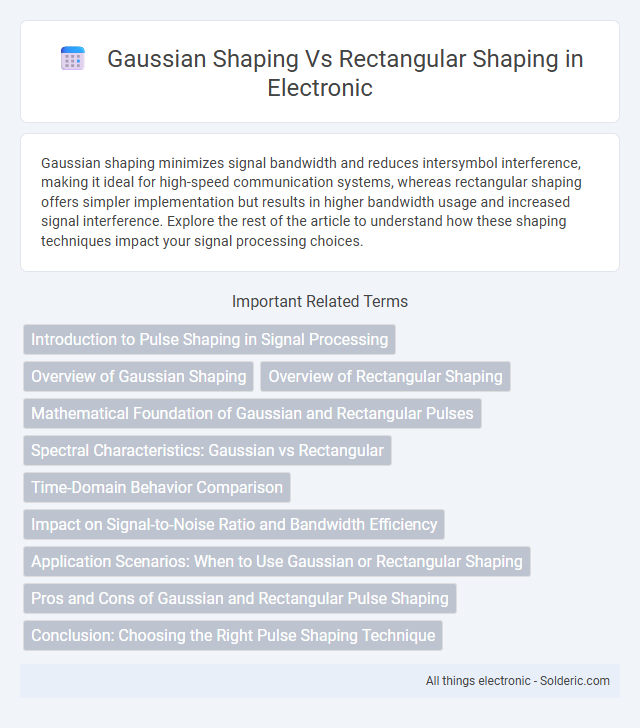Gaussian shaping minimizes signal bandwidth and reduces intersymbol interference, making it ideal for high-speed communication systems, whereas rectangular shaping offers simpler implementation but results in higher bandwidth usage and increased signal interference. Explore the rest of the article to understand how these shaping techniques impact your signal processing choices.
Comparison Table
| Feature | Gaussian Shaping | Rectangular Shaping |
|---|---|---|
| Pulse Shape | Gaussian bell curve | Constant amplitude |
| Bandwidth Efficiency | High, reduced spectral side lobes | Low, broad spectrum with high side lobes |
| Inter-Symbol Interference (ISI) | Minimized due to smooth transitions | Higher, due to abrupt edges |
| Time-Domain Behavior | Smooth, gradual rise and fall | Instant on/off transitions |
| Implementation Complexity | More complex filtering required | Simple to implement |
| Use Cases | Wireless communications, RF systems | Basic digital systems, simple pulse generation |
| Spectral Efficiency | Optimized with minimal sidebands | Less efficient, wider bandwidth usage |
Introduction to Pulse Shaping in Signal Processing
Pulse shaping in signal processing involves modifying the waveform of transmitted signals to optimize bandwidth and reduce intersymbol interference. Gaussian shaping applies a smooth, bell-shaped filter that minimizes bandwidth and spectral side lobes, enhancing efficiency in bandwidth-constrained systems. Rectangular shaping, with its abrupt on-off transitions, simplifies implementation but causes significant spectral spreading and higher interference, making Gaussian shaping favorable for your communication system's performance and signal integrity.
Overview of Gaussian Shaping
Gaussian shaping filters minimize intersymbol interference by smoothing signal transitions, resulting in a pulse with a bell-shaped amplitude envelope that reduces bandwidth and spectral sidelobes. This approach improves signal integrity and performance in bandwidth-constrained communication systems such as optical fiber and wireless channels. Compared to rectangular shaping, Gaussian pulses offer better spectral efficiency and reduced electromagnetic interference.
Overview of Rectangular Shaping
Rectangular shaping utilizes a pulse with uniform amplitude over its duration, resulting in a sharp transition and a wide frequency spectrum. This approach is simpler to implement but can cause significant intersymbol interference (ISI) due to its abrupt edges. Your system's performance may be affected by increased bandwidth requirements and potential signal distortion when using rectangular shaping.
Mathematical Foundation of Gaussian and Rectangular Pulses
Gaussian shaping is based on the Gaussian function, characterized by its bell-shaped curve defined as exp(-t2/(2s2)), which ensures minimal bandwidth and reduced intersymbol interference in signal processing. Rectangular shaping relies on a constant amplitude pulse within a fixed time interval, mathematically represented by a rectangular function that has sharp transitions and a sinc-shaped frequency spectrum. The key mathematical difference lies in Gaussian pulses having infinite temporal extent and smooth tails, while rectangular pulses are finite in time but produce significant spectral side lobes due to abrupt transitions.
Spectral Characteristics: Gaussian vs Rectangular
Gaussian shaping exhibits a smooth, bell-shaped spectral profile that minimizes out-of-band emissions and reduces interference in adjacent channels. In contrast, rectangular shaping produces a sinc-shaped spectrum with pronounced side lobes, leading to higher spectral leakage and potential crosstalk. Your system's spectral efficiency and interference tolerance significantly improve with Gaussian shaping, especially in bandwidth-constrained environments.
Time-Domain Behavior Comparison
Gaussian shaping exhibits smooth, bell-shaped pulses in the time domain, minimizing signal bandwidth and reducing intersymbol interference (ISI) effectively. Rectangular shaping produces abrupt transitions with a constant amplitude, causing significant spectral leakage and higher side-lobe levels, which increase susceptibility to ISI. The gradual time-domain roll-off of Gaussian filters enhances signal integrity, while rectangular pulses prioritize simplicity but suffer from poorer time-domain control.
Impact on Signal-to-Noise Ratio and Bandwidth Efficiency
Gaussian shaping significantly improves bandwidth efficiency by reducing spectral side lobes and tightening signal spectra compared to rectangular shaping, which exhibits higher side lobes and a wider spectral footprint. The Signal-to-Noise Ratio (SNR) for Gaussian-shaped pulses is effectively enhanced due to reduced inter-symbol interference and minimized adjacent channel interference, whereas rectangular pulses suffer from higher ISI and spectral spill-over, degrading SNR. In essence, Gaussian shaping optimizes both SNR and bandwidth utilization, making it favorable for communication systems requiring high spectral efficiency and low noise degradation.
Application Scenarios: When to Use Gaussian or Rectangular Shaping
Gaussian shaping is ideal for high-speed digital communication systems requiring bandwidth efficiency and reduced intersymbol interference, such as in wireless networks and fiber-optic transmissions. Rectangular shaping suits simpler applications with minimal filtering needs, like basic data storage or low-complexity digital systems where latency is critical. Choosing the right shaping pulse depends on your system's trade-off between spectral efficiency and implementation complexity.
Pros and Cons of Gaussian and Rectangular Pulse Shaping
Gaussian pulse shaping minimizes bandwidth and reduces intersymbol interference, making it ideal for high-speed communication systems, but it can cause more complex receiver design due to its infinite time support. Rectangular pulse shaping offers simple implementation and easy synchronization with minimal processing delay, yet it suffers from significant spectral leakage and higher intersymbol interference. Your choice depends on balancing spectral efficiency and system complexity based on specific application requirements.
Conclusion: Choosing the Right Pulse Shaping Technique
Gaussian shaping offers superior bandwidth efficiency and reduced intersymbol interference compared to rectangular shaping, making it ideal for high-speed communication systems. Rectangular shaping, while simpler to implement, causes significant spectral sidelobes that can lead to interference in adjacent channels. Your choice should weigh the need for spectral efficiency and signal integrity against system complexity and hardware constraints.
Gaussian shaping vs rectangular shaping Infographic

 solderic.com
solderic.com